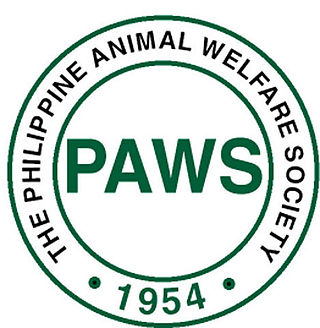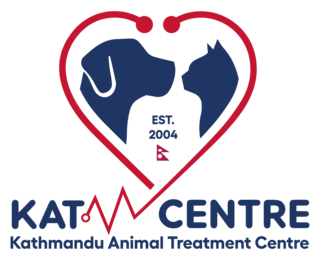Related Research Articles

The cat, also referred to as domestic cat or house cat, is a small domesticated carnivorous mammal. It is the only domesticated species of the family Felidae. Advances in archaeology and genetics have shown that the domestication of the cat occurred in the Near East around 7500 BC. It is commonly kept as a house pet and farm cat, but also ranges freely as a feral cat avoiding human contact. Valued by humans for companionship and its ability to kill vermin, the cat's retractable claws are adapted to killing small prey like mice and rats. It has a strong, flexible body, quick reflexes, and sharp teeth, and its night vision and sense of smell are well developed. It is a social species, but a solitary hunter and a crepuscular predator. Cat communication includes vocalizations—including meowing, purring, trilling, hissing, growling, and grunting–as well as body language. It can hear sounds too faint or too high in frequency for human ears, such as those made by small mammals. It secretes and perceives pheromones.

Cryptorchidism, also known as undescended testis, is the failure of one or both testes to descend into the scrotum. The word is from Ancient Greek κρυπτός (kryptos) 'hidden' and ὄρχις (orchis) 'testicle'. It is the most common birth defect of the male genital tract. About 3% of full-term and 30% of premature infant boys are born with at least one undescended testis. However, about 80% of cryptorchid testes descend by the first year of life, making the true incidence of cryptorchidism around 1% overall. Cryptorchidism may develop after infancy, sometimes as late as young adulthood, but that is exceptional.
Neutering, from the Latin neuter, is the removal of a non-human animal's reproductive organ, either all of it or a considerably large part. The male-specific term is castration, while spaying is usually reserved for female animals. Colloquially, both terms are often referred to as fixing. In male horses, castrating is referred to as gelding. An animal that has not been neutered is sometimes referred to as entire or intact.
The University of California, Davis, School of Veterinary Medicine is the largest veterinary school in the United States. Established in 1948, the school is the primary health resource for California's animal populations. In 2020, the school was again ranked first in the United States by U.S. News & World Report and in 2022, ranked second in the world by QS World University Rankings. The school is located in the southwest corner of the main campus of the University of California, Davis. The current dean of veterinary medicine is Dr. Mark Stetter.

Anti-Müllerian hormone (AMH), also known as Müllerian-inhibiting hormone (MIH), is a glycoprotein hormone structurally related to inhibin and activin from the transforming growth factor beta superfamily, whose key roles are in growth differentiation and folliculogenesis. In humans, it is encoded by the AMH gene, on chromosome 19p13.3, while its receptor is encoded by the AMHR2 gene on chromosome 12.

Meloxicam, sold under the brand name Mobic among others, is a nonsteroidal anti-inflammatory drug (NSAID) used to treat pain and inflammation in rheumatic diseases and osteoarthritis. It is used by mouth or by injection into a vein. It is recommended that it be used for as short a period as possible and at a low dose.

Gary K. Michelson is an American orthopedic surgeon, medical inventor, and billionaire philanthropist.
In mammalian species, pseudopregnancy is a physical state whereby all the signs and symptoms of pregnancy are exhibited, with the exception of the presence of a fetus, creating a false pregnancy. The corpus luteum is responsible for the development of maternal behavior and lactation, which are mediated by the continued production of progesterone by the corpus luteum through some or all of pregnancy. In most species, the corpus luteum is degraded in the absence of a pregnancy. However, in some species, the corpus luteum may persist in the absence of pregnancy and cause "pseudopregnancy", in which the female will exhibit clinical signs of pregnancy.
The estrous cycle is a set of recurring physiological changes induced by reproductive hormones in females of mammalian subclass Theria. Estrous cycles start after sexual maturity in females and are interrupted by anestrous phases, otherwise known as "rest" phases, or by pregnancies. Typically, estrous cycles repeat until death. These cycles are widely variable in duration and frequency depending on the species. Some animals may display bloody vaginal discharge, often mistaken for menstruation. Many mammals used in commercial agriculture, such as cattle and sheep, may have their estrous cycles artificially controlled with hormonal medications for optimum productivity. The male equivalent, seen primarily in ruminants, is called rut.

The health of dogs is a well studied area in veterinary medicine.

Pet food is animal feed intended for consumption by pets. Typically sold in pet stores and supermarkets, it is usually specific to the type of animal, such as dog food or cat food. Most meat used for animals is a byproduct of the human food industry, and is not regarded as "human grade".
A no-kill shelter is an animal shelter that does not kill healthy or treatable animals based on time limits or capacity, reserving euthanasia for terminally ill animals, animals suffering poor quality of life, or those considered dangerous to public safety. Some no-kill shelters will commit to not killing any animals at all, under any circumstance, except as required by law. A no-kill shelter uses many strategies to promote shelter animals; to expanding its resources using volunteers, housing and medical protocols; and to work actively to lower the number of homeless animals entering the shelter system. Up to ten percent of animals could be killed in a no-kill shelter and still be considered a no-kill shelter.

The Philippine Animal Welfare Society (PAWS) is a volunteer-based, non-government organization whose goal is to prevent animal cruelty through education, animal sheltering and advocacy, based in Quezon City, Philippines. It was founded in 1954 by Muriel Jay. PAWS believes that the creation of a more peaceful society starts with the widening of mankind's circle of compassion which includes animals, thereby envisions a nation that respects animals, practices responsible pet ownership and protects wildlife. The volunteer-based organization rehabilitates these animals in the hope of finding them new homes and a second chance at a good life. PAWS does not take in pets of other people, but only victims of cruelty or neglect where the animal offenders are charged with violation of the Animal Welfare Act in court.
Pediatric spaying or neutering is defined as performing an ovariohysterectomy (spaying) or orchidectomy on a kitten or puppy between the ages of 6 and 14 weeks. Spaying and neutering are sterilization procedures which prevent the animals from reproducing. The procedures are also referred to as “gonadectomies” in the veterinary literature.

The KAT Centre Nepal is a nonprofit organization in Nepal. The KAT Centre Nepal’s goals are to create a healthy, sustainable street dog population, reduce animal cruelty, and eliminate rabies, around Kathmandu, Nepal.
Zeuterin (zū-tur-in) is the trade name of an injectable product containing zinc gluconate and the amino acid arginine, which is used for sterilizing young male dogs without the removal of the testicles. The product is injected directly into the testicle, where the zinc gluconate destroys the sperm and causes inflammation, which leads to fibrosis and causes sterility. Sperm production continues for up to 60 days after product administration, and in some dogs does not stop completely, although the product is 99.6% effective when given to dogs aged 3-10 months of age. Following administration, the testicles atrophy; the degree of atrophy may vary noticeably between testicles. The male hormone, testosterone, is produced in limited quantities following treatment with Zeuterin, but after two years, testosterone production is similar to that in untreated dogs. The continuing presence of testosterone means that, unlike surgical castration, chemical castration does not remove the risk of testosterone-associated disease, such as prostatic disease.
Morris Animal Foundation is an animal health charity based in Colorado, United States. The Foundation advances veterinary medicine and funds veterinary research for companion animals, horses and wildlife.
The Michelson Medical Research Foundation is a private, non-profit philanthropy founded by orthopedic spinal surgeon and inventor Gary K. Michelson. The foundation aims to solve global health issues by promoting the development of innovative ideas in medicine and bioscience.

Azagly-nafarelin, sold under the brand name Gonazon, is a gonadotropin-releasing hormone agonist medication which is used in veterinary medicine in Europe. It is a GnRH analogue and a synthetic peptide, specifically a decapeptide. The medication has been approved in Europe as a solid silicone-based matrix implant for use as a contraceptive in animals such as male dogs, cats, and others, but is no longer or was never commercially available. The medication has also been used to treat benign prostatic hyperplasia in animals. In addition to its use in mammals, azagly-nafarelin has been approved for use in aquaculture fish, specifically to control ovulation in salmonids, and was the first GnRH agonist to be available for use in fish. It was introduced for use by 2005.
Non-surgical fertility control is the prevention of reproduction without the use of surgery. The most common form of sterilization in dogs and cats is surgical, spaying in females and castration in males. Non-surgical fertility control can either result in sterilization or temporary contraception and could offer a cheaper way to keep wild dog and cat populations under control. As of 2019, only contraceptives are commercially available. Research is ongoing into methods that could result in permanent suppression of fertility.
References
- ↑ Peters, Sharon L. (2008-10-15). "Inventor Michelson offers $75M for a way to sterilize pets". Usatoday.Com. Retrieved 2012-10-31.
- ↑ Conlon, Thomas (September 3, 2018). "The Michelson Prize & Grants: past, present, future". youtube.com/watch?v=4bagH2Eas50. Retrieved January 5, 2019.
- ↑ Vansandt, Lindsey M.; Meinsohn, Marie-Charlotte; Godin, Philippe; Nagykery, Nicholas; Sicher, Natalie; Kano, Motohiro; Kashiwagi, Aki; Chauvin, Maeva; Saatcioglu, Hatice D.; Barnes, Julie L.; Miller, Amy G.; Thompson, Amy K.; Bateman, Helen L.; Donelan, Elizabeth M.; González, Raquel (2023-06-06). "Durable contraception in the female domestic cat using viral-vectored delivery of a feline anti-Müllerian hormone transgene". Nature Communications. 14 (1): 3140. doi:10.1038/s41467-023-38721-0. ISSN 2041-1723. PMC 10244415 .
- ↑ Vaughan, Don (2022-08-30). "Giving It Their Best Shot". Today's Veterinary Business. Retrieved 2024-04-12.
- ↑ Grimm, David (June 6, 2023). "Hello kitty, goodbye kittens? Gene therapy spays cats without surgery". Science. Retrieved July 31, 2024.
- ↑ "Scientific research increasingly fueled by prize money" . Retrieved 2018-02-16.
- ↑ Whelan, David. "Animal Nut". Forbes. Retrieved 2018-02-16.
- ↑ "Nonsurgical sterilization research gives birth to new veterinary tools". DVM 360. 2011-11-01. Retrieved 2024-09-27.